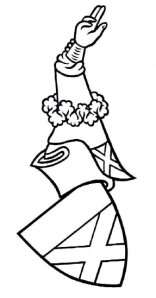There is evidence that heraldry as we know it today appeared in western Europe in the 11th century. It developed as a means of personal identification especially in warfare where it was necessary for soldiers to distinguish friend from foe.
The design on a knight’s shield was (and still is) called ‘armorial bearings’ or ‘arms’. The use of these individual designs on the fabric coat which was worn over armour gave us the term ‘coat of arms’, and it was not long before the same symbol was used by a knight to mark, beautify, and identify seals, tombs, textiles, stone, ceramics and glass.
Arms came to be used in civilian life and not only by men of a military background. Women, bishops, merchants and corporations (such as cities, guilds, monasteries, universities and schools) also made use of armorial bearings.
Heraldry, a colourful and beautiful system of identification, is a living and evolving art-form combining traditional design with contemporary symbolism.
As personal arms are hereditary and show family relationships, the study of heraldry can give valuable assistance to family historians.

